The Economic Impact of Trade Unions
It has always been assumed that employees who work in unionized firms earn more wages as compared to their counterparts in non-unionized firms. However, this has not always been the case. As a result of the wage differential factor, unionized firms usually experience more operating costs as compared to non-unionized firms. According to the competitive model, such firms might not be sustainable in the long run since they incur high operating costs. To averse this situation, it has always been advised that all firms operating in the same industry should be under one union. In this respect therefore, the impact of the union will be evenly distributed to all firms.
At the same time, it is essential to note that other than unions, there are other factors that affect the wage rate of a given firm. Demographic makeup is a prime example. The composition of a firm determines the rate at which it will pay its employees. Usually, men who work in industries tend to receive higher wages as compared to women. Consequently, large firms always aim at hiring more qualified employees than smaller firms due to the high cost of production and the fact that they are capital intensive in nature. In the process, they tend to pay their employees at a higher rate to reduce their human resource turnover rates.
Unions play a critical role in determining the wage rates of employees in a given firm or industry. They have an effect of either increasing or decreasing the wage rates of employees within a given firm and the entire industry in general. Thus, unionized firms enjoy pure union wage advantage. The formula below is used to calculate the pure wage advantage:
A= Wu-Wn x 100/Wn.
Where A is the pure union advantage, Wu is the union wage and Wn is the non-unionized wage. To express the resultant figure as a percentage, the result is multiplied by 100. However, this method is not ideal as it fails to consider other factors that might result in achieving pure wage advantage. To ensure that all the factors are considered, the comparison should be conducted in a lab to reflect an ideal situation. However, in reality, it is impossible to achieve such standards.
The increase in unionized wages has several effects on the wages of non-unionized firms. The spillover effect is used to explain the effects of a decline in non-unionized wages as a result of an increase in unionized wages. The figure below explains this in detail.
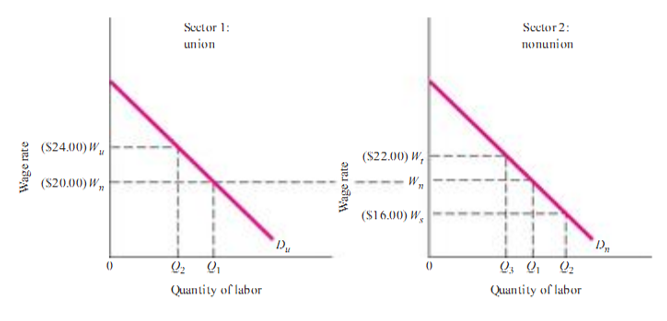
In sector 1 above, an increase in wages from Wn to Wu is as a decline on the quantity of labor from Q1 to Q2. If a situation arises whereby the workers who have been laid off seek for employment in non-unionized firms, the quantity of labor will rise from from Q1 to Q2. In the process, the wage rate will decline from Wn to Ws, a rate that is lower than Wu. The threat effect on the other hand argues that an increase in unionized wages will result in an increase in non-unionized wages. This is achieved through collective bargaining, a concept that is used to achieve equitable wage rates within the industry. Other effects include the product market effect, the wait employment effect, and the superior worker effect.
Studies that have been conducted put the pure wage advantage between 1983-2009 at 17%. This is higher than the study that was conducted between 1923-58 that put the pure wage advantage at 10-15%. Despite this, these studies revealed that wage differential of unionized firms is higher during recession periods (during the 1970s and since 1994-2009). This trend is to collective bargaining and adjustment to the cost of living.
Consequently, the wages of non-unionized firms seem to be in line with economic trends, falling during recessions and rising during booms. Unionized employees also receive higher fringe benefits as compared to non-unionized employees. However, for these benefits to be of economic advantage, they should not be enjoyed at the expense of unionized wages.
Unions have positive and negative impacts in the overall operations of firms. On the negative aspect, unions might have a significant effect on the rules and regulations that govern the work conducted by employees. Unions usually reduce the working rate of employees. They also advocate for techniques that are time consuming and require unnecessary work hence necessitating the need of an increased work force. At the same time, unions advocate for strikes. However, strikes have minimal impacts on the operations of a given organization since they do not last for long. Therefore, the resultant effect that they have on the productivity of a given employee in a year is minimal. The figure below shows the impacts of strikes on employee productivity from 1960-2010 in the USA.
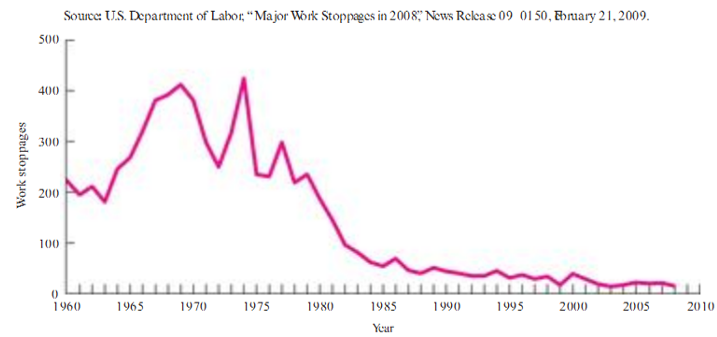
On the other hand, unions have a positive impact on the welfare of employees as well as the firm. Through unions, firms tend to improve their production techniques as a means of reducing their operating costs due to high wages. In the process, firms come up with modern production methods that use more machines than human labor hence boosting productivity. Unions also provide employees with a collective voice. This is essential in the sense that employees air their grievances as a group and not as individuals hence easing the process of solving disputes with the management. Through collective bargaining, the working conditions of employees have been improved over time resulting in low turnover rates. Unions also enhance incentives such as job security, promotion, and training.
It is argued that unions support inequality within the working sector by increasing the wage rates of unionized firms at the expense of non-unionized firms, increasing the wages of skilled employees within a firm at the expense of non-skilled employees, and increasing the need for skilled labor within a firm. However, mechanisms have always been put in place to ensure that firms have uniform wage rates regardless of the skills and expertise of an individual employee. Therefore, unions play a critical role in determining the wage rates of employees hence affecting their productivity, profitability and the general wage rate of the entire industry.
Government and the Labor Market: Employment, Expenditures, and Taxation
This chapter focuses on the impact of government spending and taxes on the wages and rates of employment in the private sector. In the USA, the government always acts as the main employer. Due to social demands, it is essential for the government to have a strong workforce to work on the various sectors of the economy to supply the society with basic as well as auxiliary goods and services.
However, from a critical point of view, the individuals who are employed in the public sector reduce the supply of labor in the private sector. Due to the positive economic growth that the USA has been experiencing since 1950, the rate of employment has increased in the public sector in accordance to the labor demand and supply model that is determined by the US population growth, urbanization, the demand for public services and firm unionization.
The same trends have also been experienced with regards to the wage rate. It has also been identified that employees in the public sector receive higher wage rates as compared to their counterparts in the private sector. This rate is maintained by the prevailing wage rule that ensures that the wage rate is maintained at a relatively similar level in either the public or the private sector. However, factors such as employee qualifications, gender, race and level of employment affect the wage rate and determine wage differentials.
The US military has a huge impact on the public employment sector in the USA. In 1970, the number of military personnel was estimated to be around 3 million. However, this number has greatly reduced to 1.4 million in 2008. This reduction can be attributed to the shift in the military recruitment exercise from the drafting exercise to the volunteer method. Despite its criticisms, the military has always advocated for the volunteer method since it is less costly, more professional and provides employment and training opportunities to lowly skilled civilians who earn minimum wages within the society.
From analysis, it is evident that the draft method will not reduce the cost that the society incurs in maintain the military.
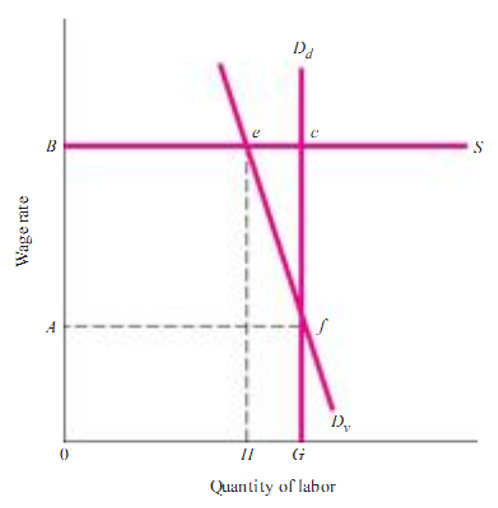
In the above graph, the labor demand is represented by the inelastic curve Dd. Therefore, if the level of employment set by the congress is OG, then the society will incur the opportunity cost contained in the area OAfG while the drafted individuals will incur the cost under the area ABcf. In this analysis therefore, it is evident that the drafting method will not reduce the cost levied to the society in maintaining the military. The volunteer method on the other hand increases the expenditure in maintaining the military by the congress and taxpayers. In this model, the demand and supply of labor will be presented by the curves Dv and S respectively. Thus, the cost of maintaining the military will be presented by the area OBeH. This area is larger than OAfG that was covered under the draft approach.
Government spending also plays a critical role in increasing labor demand in the private sector in the production of goods and services. In the process, it affects the wages of employees in the private sector through transfer of payments and subsidies. The demand generated from government spending forces the private sector to employ more individuals to increase their process of production and output.
Government spending has short term and long-term effects on the supply of labor in the private sector. In the short term, individuals will spend much of their income on highly priced goods and services. However, due to the substitution effect, the consumers will start to spend on cheaper goods and services. Thus, the private sector will have to adjust its workforce to meet these changes in supply from government expenses in the short run and in the long run.
Publicly produced goods also play a critical role in determining the demand of labor in the public and private sector. In the graph below, the demand curve of an individual earning an income of Ypu is presented by W W’. However, given the fact that such an individual enjoys public goods, his level of income will be raised to Y1. To achieve this level of income, the individual needs to work h1 hours. However, if his demand is shifted to W1 W’1, he will earn a higher income (Y2). At this time, his level of leisure will increase at the expense of work since he will have to work h2 hours. Therefore, an increase in the supply of public goods and services will reduce the demand of labor in the private sector.
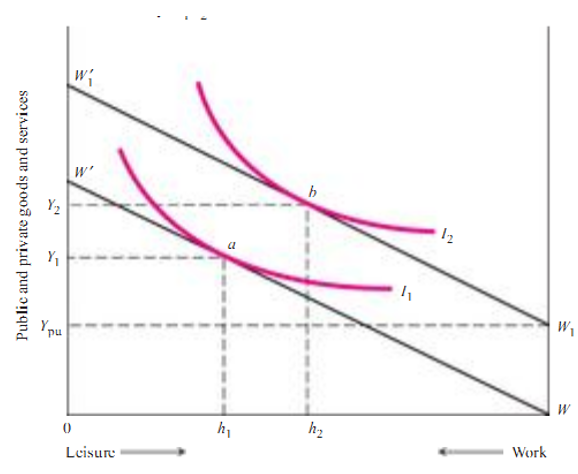
Government and the Labor Market: Legislation and Regulation
Other than the government playing a critical role in the creation of employment in the public sector, it is also responsible for developing the rules and regulation that govern the labor market and employment in the United States of America. This move has greatly led to the growth of labor unions in the USA and the establishment of rules and regulations under which employees fight for better wages and working conditions through collective bargaining.
Before the 1930s, the USA did not have labor laws. Therefore, union members did not receive any form of protection from either their employers or the government (through the judicial system). Thus, leaders and members of unions suffered by either losing their jobs or being prosecuted before the court of law. Consequently, firms forced their employees to sign yellow-dog contracts that restricted them from joining any union in the course of their employment. Since labor laws were not present, the judgment of union members was based on case laws. Since 1930 however, several laws that strengthen the participation of employees in unions have been passed.
Norris LaGuardia Act of 1932 is a prime example. The enactment of this law has increased the protection of employees who are union members. The Wegner Act on the other hand has enhanced the growth of unionism to support self-organization and collective bargaining among employees. Due to the success of unionism in the private sector, a presidential decree was passed increasing the participation of federal employees in unions during the 1960s and 1970s.
Increasing and sustaining the minimum wage has always been a critical agenda of labor unions. The fair labor standards of 1938 was established to govern minimum wage in the USA. As such, minimum wage has always been in line with the economic performance of the nation. However, the resultant impacts of minimum wage on wages and the level of employment have always been controversial.
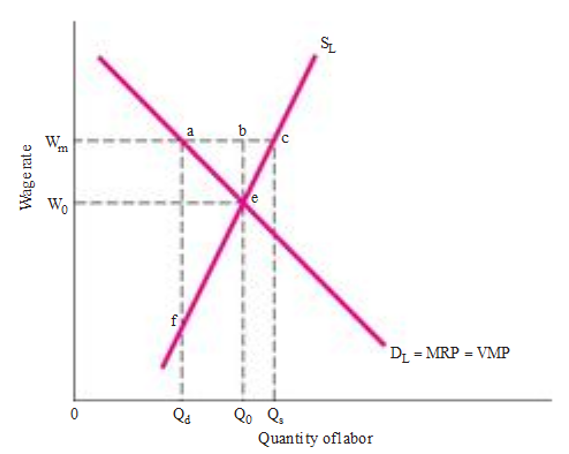
The figure above shows the competitive labor model in action. This model only operates when the minimum wage (Wm) is above the equilibrium wage (Wo). According to this model, an increase in minimum wage will result in a decrease in the demand of labor (shown here from Q0 to Qd). Firms will decrease their rates of employment to maximize on their profits. However, at this level, the supply of labor will increase as more employees want to enjoy the high wages. In this respect therefore, the level of unemployment will be higher (Qs-Qd). Other than this, the minimum wage law does not have a significant effect on poverty reduction. However, it plays a critical role in making human capital investment decisions in firms.
Other than ensuring that employees receive desirable wage rates, the government, through the occupation health and safety Act of 1970 ensures that employers provide a safe working environment for their employees.
However, on the minds of profit maximizing firms, providing safety to employees means an increase in operating expenses. From a different perspective however, employers realized that providing a safe working environment for their employees might yield benefits such as employing more employees at lower rates (due to the perceived safe working environment), reduction in recruitment costs and low employee turnover rates. To ensure that firms oblige to the occupation health and safety act, the government established the Occupation Safety and Health Administration (OSHA), a body that develops health hazards standards that are to be adhered to in different work environments.
The government also provides economic rent to its labor force. From a critical point of view, this move might be regarded as an extra cost to the government. However, there are those individuals who believe that economic rent is a political move aimed at keeping politicians into power. Consequently, imposition of economic rent might be a move to safeguard local industries from competition by levying of tariffs and quotas on imported goods. This move ensures the sustainability of local industries hence maintaining a high level of employment.
Labor Market Discrimination
Discrimination on the grounds of race, gender, sexual orientation, and religion has a huge impact on the labor market. During the 1970s for instance, the hourly wage rate of men was higher than that of women. However, this gap has been closing down over time due to increased skill level of women, reduction in discrimination, the impact of industrial restructuring programs and occupational distribution that have positive impacts on women.
However, there has not been a considerable change in the wage rate of African Americans regardless of their gender. At the same time, the level of unemployment is generally higher on African Americans as compared to White Americans. The fact that White American males have a higher chance of accessing college education has increased their employment rates as compared to White American women and African Americans.
In fact, it is believed that that African Americans receive an inferior quality of education. Considering post-market discrimination factors such as discrimination on the grounds of wages, employment, and occupation, African American women have been greatly affected as compared to White American males. The same trend applies to human capital discrimination (pre-market discrimination).
No single theory can explain the impact of discrimination in the labor market. However, the Taste for Discrimination theory advanced by Becker is a powerful tool in determining the effects of discrimination. This model assumes that employers are like nations who instead of enjoying the effects of comparative advantage in international trade, impose tariffs and quotas to protect domestic industries.
Thus, prejudiced employers would rather employ workers from a given race regardless of the benefits that they may gain while employing individuals from other races. For such an employer to employ individuals from the undesired race, the cost of employment has to be less than that which he/she would incur while employing individuals from the desired race. The advantage that such an employer will gain in result is referred to as the discrimination coefficient.
The Theory of Statistical Discrimination is another model that employers use during their recruitment exercises. According to this model, an employer considers the characteristics of a given group (either on the basis of gender, race or age) to determine whether to make employment decisions in an even where all the candidates hold similar qualifications.
Scholars regard this method superior to Becker’s theory since it results in the making of correct, rational, and profitable decisions by employers hence making them benefit in the end. Using the demand and supply of labor analysis, the Crowding Model reveals that the wage rate of African American women is lower as compared to that of White American males. However, this discrimination has greatly reduced the level of output in American firms.
Therefore, the high level of discrimination in the labor market in the USA has resulted in the development of laws and policies to curb this phenomenon. The Equal Pay Act of 1963 is a prime example. The aim of this Act is to ensure that employees who have similar qualifications receive a relatively similar amount of pay for their work regardless of their age, gender, race, or any other ground of discrimination.
Consequently, the Civil Rights Act of 1964 ensures that individuals of all races in the USA enjoyed similar rights including employment and wages regardless of the ethnic background, race, or religion. However, despite the presence of these laws and policies, discrimination is still present in the labor market in the USA. However, this phenomenon has been reducing over time.